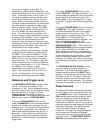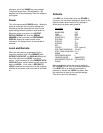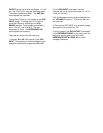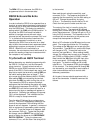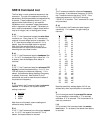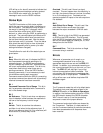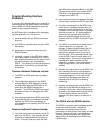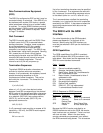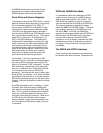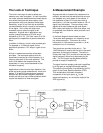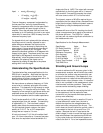
18
n Status
0 Local: all front panel keys are operative
1 Remote: front panel keys are not
operative. The display up key returns the
status to local.
2 Lock-out: front panel keys are not
operative. No key returns the status to
local. Another I command is needed to
return to local.
When using the GPIB interface, the REN, LLO,
and GTL commands are not implemented. The I
command is used by both interfaces to set the
remote-local status.
J {n1,n2,n3,n4}
The J command sets the RS232 end-of-record
characters sent by the SR510 to those specified
by the ASCII codes n1-n4. If no argument is
included, the end-of-record sequence returns to
the default (a carriage return), otherwise, up to
four characters may be specified. The end-of-
record required by the SR510 when receiving
commands is not affected.
K n
The K command simulates a front panel key
press. The effect is exactly the same as pressing
the selected key once. The parameter n is
required.
nKey
1 Post Time Constant Up
2 Post Time Constant Down
3 Pre Time Constant Up
4 Pre Time Constant Down
5 Offset Up
6 Offset Down
7 Zero Phase (Simultaneous 90¡ Up and
Down)
8 Line Notch Filter
9 Bandpass Filter
10 Line X 2 Notch Filter
11 Relative (Auto Offset)
12 Offset (On/Off)
13 Expand
14 Local (Display Up when REMOTE)
15 Reference Trigger Mode
16 Reference Mode (f/2f)
17 Degrees Up
18 Degrees Down
19 Quad Up
20 Quad Down
21 Select Display (f/phase)
22 Sensitivity Up
23 Sensitivity Down
24 Dyn Res Up
25 Dyn Res Down
26 Display Up
27 Display Down
L m {,n}
The L command sets and reads the status of the
line notch filters. If m is "1", then the 1X line
notch is selected, if m is "2", the 2X line notch is
selected. The parameter m is required. If n is "1",
the L command sets the selected filter in. If n is
"0", the selected filter is taken out. If n is absent,
the status of the selected filter is returned.
M {n}
If n is "1", the M command sets the reference
mode to 2f. If n is "0", the reference mode is set
to f. If n is absent, the reference mode is returned.
N {m}
If m is "1", the N command sets the ENBW to 10
Hz. If m is "0", the ENBW is set to 1 Hz. If m is
absent, the ENBW setting is returned.
O {n} {,v}
If n is "1", the O command turns the offset on. If n
is "0", the offset is turned off. If n is absent, the
offset status (on or off) is returned. (The value of
the offset is read using the S and Q commands.)
If n is included, then v may also be sent. v is the
offset value up to plus or minus full scale in units
of volts. For example, to offset half of full scale on
the 100 µV sensitivity, v should be "50.0E-6" or an
equivalent value. However, if the sensitivity is
then changed to 200 µV, the offset is now half of
the new full scale or 100 µV. When the sensitivity
is changed, the offset is retained as a constant
fraction of full scale rather than as a voltage
referred to the input. The expand function will, on
the other hand, preserve the value of the offset as
an input referred voltage. Once a value of v is
sent, the offset may be turned off and on without
losing the offset value by using the O command
without the v parameter. Note that if the auto
offset is on, an "O 1" command will turn the auto
offset off and turn the manual offset on without
changing the actual offset value.
P {v}
If v is absent, the P command returns the phase
setting from -180 to +180 degrees. When v is
included, the phase is set to the value of v up to
±999 degrees.




